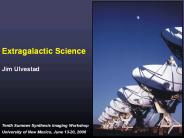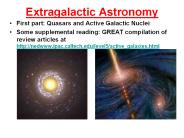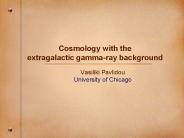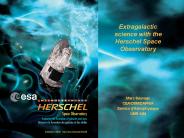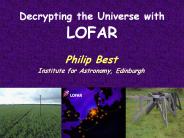Extragalactic PowerPoint PPT Presentations
All Time
Recommended
Most populated class of EGRET identified sources. Only class with identified members at high z ... EGRET constraints on the unresolved blazar emission spectral ...
| PowerPoint PPT presentation | free to download
Tenth Summer Synthesis Imaging Workshop. University of New ... Brighten and deflect. Gomez et al. 2000. 26. Where Most X-rays & ?-rays Are Emitted. clouds ...
| PowerPoint PPT presentation | free to download
Extragalactic Astronomy
| PowerPoint PPT presentation | free to download
Extragalactic Science
| PowerPoint PPT presentation | free to download
Cosmology and extragalactic astronomy Mat Page Mullard Space Science Lab, UCL 10. Inflation You are the result of a quantum fluctuation! Galaxies, Planets, You 11.
| PowerPoint PPT presentation | free to view
for the first time, to compare high-redshift & low-redshift samples ... There is an astonishing amount of agreement---we understand the X-ray samples very well! ...
| PowerPoint PPT presentation | free to download
Cosmic Microwave Background (CMB) is an 'echo' of the Big Bang. ... Has same spectral behavior as CMB anisotropy. Difficult to correct for, but relatively minor. ...
| PowerPoint PPT presentation | free to download
Again, a detailed knowledge of names, dates and places is not required ... brightness changed - outer sphere of star does change! a Comet ...
| PowerPoint PPT presentation | free to view
Cosmology and extragalactic astronomy Mat Page Mullard Space Science Lab, UCL Particles in the hot, early Universe. Particles This lecture: Particles in the hot early ...
| PowerPoint PPT presentation | free to view
... are possibilities as they fit the properties of homogeneity/isotropy ... OK, homogeneity, isotropy, local flatness, tidal forces & reduction to Newtonian ...
| PowerPoint PPT presentation | free to download
Early Extragalactic Results from Spitzer
| PowerPoint PPT presentation | free to download
How Black Holes change their host galaxies ... Oxford-COSMOCT Workshop on AGN feedback on host galaxies: Observations and Modelling ...
| PowerPoint PPT presentation | free to download
In 1905 particle/wave duality of light known. Rutherford had ... Quantum laws show us that all tiny particles exhibit the wave-particle duality known for light ...
| PowerPoint PPT presentation | free to download
Lecture 35 Extragalactic Astronomy. Summary so far. Still ... Every 50 100 Mpc. Virgo cluster, p601. 20 Mpc. Neighbor small ... Characteristics ...
| PowerPoint PPT presentation | free to view
If M varies with radius, and v is constant. Mass proportional to radius ... This is a NaIAD detector from UKDMC, Boulby Mine. Look for recoil from 'Heavy WIMP' ...
| PowerPoint PPT presentation | free to view
Planetary Nebulae and the Extragalactic Distance Scale. Robin Ciardullo. Why Measure ... Collisional de-excitation of forbidden emission in young, dense nebulae ...
| PowerPoint PPT presentation | free to download
Scintillation in Extragalactic Radio Sources Marco Bondi Istituto di Radioastronomia CNR Bologna, Italy References Conference Proceedings & Review Papers: AIP #74 ...
| PowerPoint PPT presentation | free to download
Lucy 1991. Proc. 3rd ESO/ST-ECF data analysis workshop eds ... Lucy 1992. AJ, 104, 1260. Perfect Instrument: records exact position of n. Ideal reconstruction ...
| PowerPoint PPT presentation | free to download
Found in nearby star-forming galaxies, starbursts, and AGNs. ... Structures of exotic star-formation in outer galaxies. ... star-forming galaxy, hosting a low ...
| PowerPoint PPT presentation | free to download
Science (in press) astro-ph/0709.4301. Talk Outline. Dispersion by the ... A dedicated search. Green Bank Extragalactic Radio Transient Experiment (GERTIE) ...
| PowerPoint PPT presentation | free to download
Extragalactic Background Fluctuation. Two-body correlation function of galaxies ... Extragalactic background light. Our catalog fits the 2MASS results quite well ...
| PowerPoint PPT presentation | free to download
Introduction: cosmic ray origin problem. Gamma-flux of SMC a key for this ... The experimental results (EGRET data) were obtained about 15 years ago and gave ...
| PowerPoint PPT presentation | free to download
Relevant characteristics of GC systems. Globular Cluster/Galaxy Formation. Sub-populations ... At distance of Virgo 6 hrs with Keck H errors: /- 0.15 0.3 ...
| PowerPoint PPT presentation | free to download
Some big questions future AO could address. Assembly of galaxy masses. ... Formation of bulges and tie to central black hole. ...
| PowerPoint PPT presentation | free to download
Extragalactic science with the Herschel Space Observatory Marc Sauvage CEA/DSM/DAPNIA Service d'Astrophysique UMR AIM
| PowerPoint PPT presentation | free to download
This section extends the work done in the first section, generalising from ... Graph taken from Essential Pure Mathematics, J. K. Backhouse et al., Longman ...
| PowerPoint PPT presentation | free to view
That there is a connection is clear from the various correlations found between star ... Stars form in spiral arms. M33 Spitzer Image. From Verley et al. ...
| PowerPoint PPT presentation | free to view
So you've won your Nobel prize... What now? Build better detectors! ... Age of Universe = 13.7 - 0.2 x 109 years. Decoupling occurred after 379 -8 x 103 years ...
| PowerPoint PPT presentation | free to view
IAU Colloquium #182 'Sources and Scintillations: Refraction and Scattering in ... significant trend of increasing flicker amplitude with decreasing galactic latitude. ...
| PowerPoint PPT presentation | free to view
Blue Supergiants as a Tool for Extragalactic Distances
| PowerPoint PPT presentation | free to download
... how much gas mass is converted to stars per unit time per unit cosmic volume ... Characteristic normal galaxy spectral feature imprinted on spectral shape of ...
| PowerPoint PPT presentation | free to download
Resolving contribution of unexpected EBL sources ... galactic. sources. CTA HE. COBE data (Hauser & Dwek, 2001) Goal 3: distance = Hubble parameter ...
| PowerPoint PPT presentation | free to view
SPIRE PS imaging 3-10 mJy 5s 1hr (obs. mode dependent, but all three bands) PACS PS imaging 3 mJy 5s 1hr (two bands simultaneously) ...
| PowerPoint PPT presentation | free to download
Shapley had MW size too big and therefore argued 'NO', they are part of MW ... of the galaxy explaining the central bulges that had been observed in galaxies. ...
| PowerPoint PPT presentation | free to view
Lensing galaxy in the center. Other images are lensed images of distant quasar. Gravitational Lensing. Gravitational Lens: Einstein Ring. M87 Nucleus and Black Hole ...
| PowerPoint PPT presentation | free to view
The CDS has put in place a system for advising on the structure for such ... For extragalactic PN actually residing in galaxies all the objects occur within ...
| PowerPoint PPT presentation | free to download
a candidate: 1855 37 (Giroletti 05) 1855 37: a jet turning off? 1855 37 ... Tsyn ~ 105-106 yr. vadv, syn c. consistent with slow/ceased advance in the ...
| PowerPoint PPT presentation | free to view
Current millimeter interferometers have collecting areas between 500 and 1000 m2. ... plateau at 5000m altitude is superior to all existing mm observatories. ...
| PowerPoint PPT presentation | free to download
in extragalactic HII regions and HII galaxies, I( ) 10-4 I(H ... GEHRs in dwarf galaxies. Models for the Solar. vicinity (RG=8 kpc) : high wind yields ...
| PowerPoint PPT presentation | free to view
Scientific requirements of ALMA, and its capabilities for key-projects: extragalactic ... 183 GHz water vapour radiometer: Used for atmospheric path length correction ...
| PowerPoint PPT presentation | free to download
The Discovery of Extragalactic Magnetic Fields in OH Megamasers
| PowerPoint PPT presentation | free to view
The number densities of galaxies (galaxies/deg2/magnitude) as a function of ... a two-dimensional probability distribution from this model, convolve it with ...
| PowerPoint PPT presentation | free to view
Jump conditions (e.g. Spitzer 1978): r2/r1 = 4M2/(M2 3) T2/T1 = (5M2 1)(M2 3)/16M2 ... Spitzer 4.5 mm. Dynamical: Merger gas causing old radio lobes to separate ...
| PowerPoint PPT presentation | free to view
X-ray Measurements of AGN Evolution and the Growth of SMBH ... the 1970's revealed a high degree of CXRB isotropy CXRB mainly extragalactic. ...
| PowerPoint PPT presentation | free to view
... the integrated flux of galaxies too faint to be detected as discrete objects. ... the data we used a grid with a spacing of 0.4 in mag and 0.14 in log re. ...
| PowerPoint PPT presentation | free to view
Title: Opening a New Window on the EM Spectrum with the LWA Author: Namir E. Kassim Last modified by: Greg Taylor Created Date: 9/30/2004 3:59:39 PM
| PowerPoint PPT presentation | free to view
SWIRE view on the
| PowerPoint PPT presentation | free to view
... and 9.3% of the WMAP three-year cataloged sources are 5 detections at V and W band respectively. ... 291 WMAP cataloged point sources, 75 newly detected sources ...
| PowerPoint PPT presentation | free to view
... planetary nebulae as diagnostic probes for galaxy evolution ... How far are XPN useful probes for the study of resolved stellar populations in galaxies? ...
| PowerPoint PPT presentation | free to download
The quasar J1819 3845 is one of the most extremely variable extragalactic ... It has been confirmed that the source of this variability is interstellar ...
| PowerPoint PPT presentation | free to download
Hydra A. Faraday. Rotation. Measures (magnetic fields) Taylor et al 1991. June 29, 2006 ... Hydra A. Radio. X-rays. Nulsen et al. 2004. June 29, 2006. 21 ...
| PowerPoint PPT presentation | free to view
... case. Epoch of Reionisation with LOFAR. LOFAR extragalactic surveys ... Deepest extragalactic radio surveys. 2p sr at 15,30,60,120,200MHz to unparalleled depths ...
| PowerPoint PPT presentation | free to download
AVO Demonstration 2004: Science Background to Extragalactic Case. Paolo Padovani ... Extragalactic Case. Very focused problem: find high-power ... Extragalactic Case ...
| PowerPoint PPT presentation | free to view
Stellar and extragalactic sources are easily distinguished. X-ray, opt. X-ray, opt. ... Extragalactic source. classifications more. ambiguous owing to. class ...
| PowerPoint PPT presentation | free to download
Scope of Talk: Observations of Extragalactic Radio Sources with Radio Interferometers ... Advantages of Interferometric Observations of Extragalactic Radio Sources ...
| PowerPoint PPT presentation | free to download
The LISA Gravitational Wave Interferometer. Implementation within Geant4 ... 2. Extragalactic cosmic rays. Protons, Alphas. Isotropic flux. MeV TeV energies ...
| PowerPoint PPT presentation | free to download


